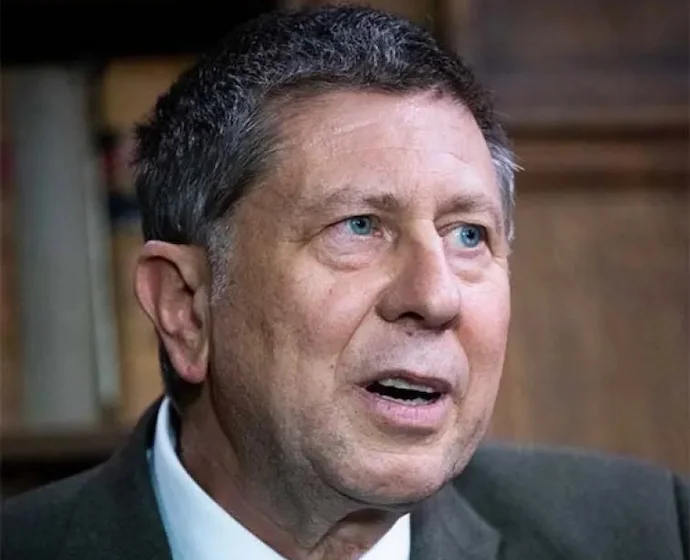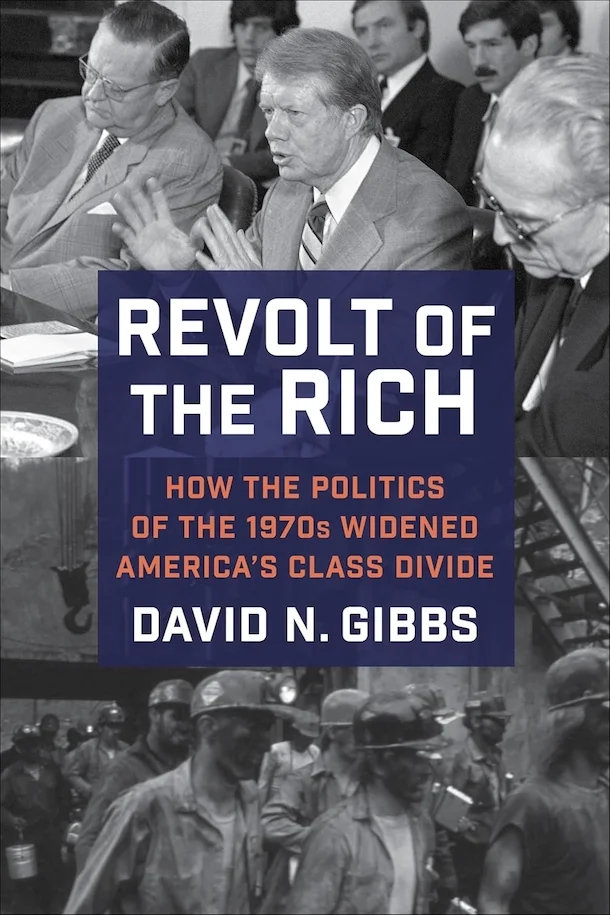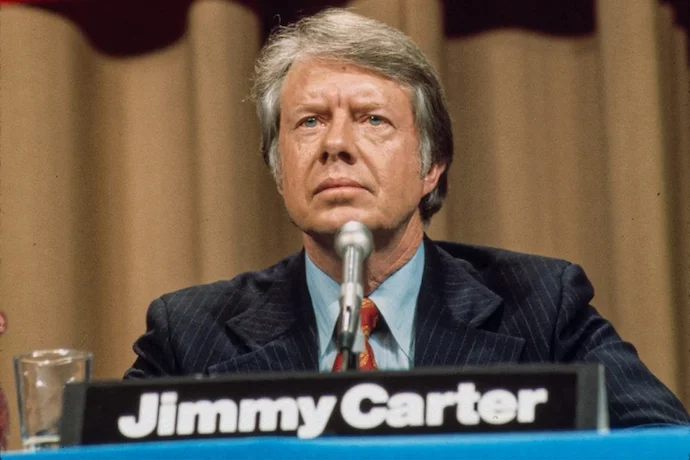
The ‘Revolt of the Rich’: How the 1970s Reshaped America’s Economic Divide
David N. Gibbs, a historian at the University of Arizona, explores the forces that reshaped U.S. economic policy in his book Revolt of the Rich. He traces how a conservative coalition of business elites, militarists, and social conservatives emerged in the 1970s, driving an agenda of deregulation, financialization, and the erosion of labor rights. This alliance, Gibbs argues, concentrated wealth and power at the top of American society.
Though many attribute neoliberalism to the Reagan era, Gibbs reveals that its seeds were planted during Jimmy Carter’s presidency. Reagan merely built upon a foundation of pro-business policies already in motion. Today, the political right continues to mobilize working-class voters, while the left struggles with fragmentation. According to Gibbs, economic inequality endures because no political force has effectively organized the working class—a vacuum that conservative movements have skillfully exploited.

Scott Douglas Jacobsen: In the 1970s, a coalition of business and social conservatives, along with militarists successfully promoted a free-market agenda. How did these seemingly disparate groups come together to drive that economic and political shift?
David N. Gibbs: The 1970s was a decade of crisis, marking a significant inflection point in U.S. history. It represented a transition away from the more labour-friendly policies of the New Deal and what could be called the Extended New Deal, which had moderated wealth distribution between rich and poor. That system broke down in the 1970s, leading to a sharp shift in American economic policy toward the free-market economics of Milton Friedman and Friedrich Hayek. These changes resulted in policies that overwhelmingly favoured high-income individuals and large business interests while becoming significantly less favourable to labour.
This shift occurred through a deliberate and concerted effort by business interests and wealthy individuals. They had grown intolerant of the New Deal’s labour-friendly policies and sought to repeal them, fundamentally altering the character of American society—which they ultimately achieved.
The primary trigger for this shift was historically low profit rates. During the 1970s, profit rates reached record lows for the postwar period. Additionally, inflation was high, and contrary to popular belief, it disproportionately affected the wealthy. Thus, business elites and the wealthy faced a one-two punch: low profits and high inflation.
Their solution was to invest enormous sums of money in fundamentally reshaping American politics. They engaged in deep lobbying—not just lobbying the government directly but influencing the entire climate of opinion. The idea was that shaping the intellectual and ideological landscape would have a far more enduring impact than simply pushing for specific legislative changes.
This effort was carried out with an unusual degree of unity among upper-class interests. Usually, different sectors of business conflict with one another, but in this case, they set aside their differences to pursue a shared goal. This was a well-planned, strategic initiative. In my archival research, I examined private papers from individuals involved in this movement and was struck by the strategic focus they applied.
First, they united business interests around a common cause. They then allied with militarist interests—particularly the military-industrial complex, which sought a greatly expanded military budget. They created a powerful coalition that successfully reshaped American economic and political structures.
Finally, they recruited social conservatives who weren’t particularly interested in economics but were deeply concerned with social issues. These individuals opposed abortion and resisted what they saw as secularist trends in America. You might say they rejected the major cultural changes of the 1960s.
This was when the United States experienced a significant expansion of evangelical Christianity. There was an explosion of interest in evangelicalism, largely among people who were not focused on economics and not part of the elite. These were mostly members of the working and middle classes. Business interests, however, saw an opportunity to make common cause with them, pushing simultaneously for free-market economics, militarist expansion, and social conservatism. They succeeded in uniting disparate groups of people with little in common.
But they did this because they needed a majority. In private, they acknowledged that there aren’t enough of us elites to win elections. They recognized that a mass base was necessary. In some ways, they learned from the political left, which had long focused on mobilizing mass movements. Conservatives studied and adapted these tactics, understanding that securing a broad base was essential for long-term political success. That mass base, they determined, would be evangelical Christianity.
Thus, business interests poured money into evangelical churches and significantly shaped the Christian Right as a political force. Their overarching strategy was fusionism, which involved merging multiple sectors of the conservative movement into a unified coalition and emphasizing majority support to drive fundamental policy changes. They were highly disciplined and strategic in this effort.
Reviewing their private papers, I was struck by how these individuals formulated and executed their strategies. Watching how they planned and implemented their policies was reminiscent of generals orchestrating a military offensive. Their level of discipline and focus was extraordinary.
By the late 1970s, they had achieved enormous success. By the second half of the Carter presidency, they had already begun securing the policy changes they sought. These changes had the predictable effect of concentrating wealth at the top, lowering the population’s living standards. That was their project, and ultimately, they achieved it.

Jacobsen: How did the ideological narratives crafted by this coalition redefine the public discourse on economic policy?
Gibbs: There was a clever and deliberate emphasis on language. Conservatives have always been skillful in shaping discourse, using short, simple phrases to redefine key concepts.
For example, they took words like liberty and freedom—which have a broad range of meanings—and redefined them specifically as freedom from government regulation. Of course, freedom and liberty can encompass various interpretations, but they carefully framed these terms to prioritize economic freedom, particularly for the wealthy.
That was their technique. They emphasized using market language to describe almost every aspect of human activity. This transformation extended beyond economics and deeply influenced the social sciences. Market theory concepts insinuated themselves into economics, political science, and sociology. The new language that emerged from Friedman and Hayek’s free-market economics reshaped these disciplines.
By contrast, the political left increasingly adopted academic jargon during this same period. Consider, for example, the term intersectionality. It appeals primarily to those with advanced humanities and social sciences degrees, but to people outside academic life, it comes across as vague and condescending.
Meanwhile, wealthy elites and the theorists they employed made a much better strategic decision. They communicated their ideas using simple, clear, and often Anglo-Saxon-rooted words, which made their arguments more accessible and persuasive. This gave them a significant advantage in shaping public discourse.
Jacobsen: What has been the role of academic institutions, think tanks, and intellectuals in legitimizing laissez-faire economics?
Gibbs: The widespread myth is that academics are overwhelmingly far-left and radical. That perception is only true on cultural issues. On topics like abortion rights, feminism, and transgender rights, universities do lean to the left. However, that is not the case when it comes to economics.
In reality, universities—particularly economics departments—are quite conservative. The image of the radical left-wing academic is largely a myth. Academics conduct much of the deep lobbying I have described. Wealthy individuals often hire academics as the intellectual architects of the social and economic transformations they seek.
Academics were valuable for two key reasons. First, they could develop new ideas that benefited the wealthy. Second, they possessed public credibility. Unlike traditional lobbyists—who are legally required to register—academics were not classified as lobbyists. They had an aura of objectivity, which made them far more effective at influencing public opinion and policy. They could advocate for corporate interests while maintaining a veneer of scholarly neutrality.
Academics played an instrumental role in implementing the policy shifts that made the United States a more plutocratic society by the decade’s end. I highlight two key networks of academics.
The first was the Mont Pelerin Society, founded in 1947 in Switzerland. This organization brought together corporate-funded free-market economists, including Friedrich Hayek, one of its founding members. By the 1970s, the Mont Pelerin Society had grown enormously in influence. Many of the free-market movement’s most significant economic innovations originated from economists affiliated with this network and its associated think tanks, such as the American Enterprise Institute (AEI) and the Hoover Institution.
The second major network consisted of militarist-oriented academics. A key organization in this area was the Committee on the Present Danger, which lobbied for a substantial increase in U.S. military spending. This effort aligned closely with the goals of free-market lobbyists, as both groups sought to expand corporate power—whether through deregulation or increased defence contracts.
This movement was led by Eugene Rostow, a law professor at Yale University, and included many top-tier intellectuals and academics. What emerged was a situation in which the conservative revolution in America—and it truly was a revolution—was made possible in large part by right-wing academics, who played a crucial role in bringing it to fruition.
Additionally, the Nixon administration employed policy strategists to embed free-market principles into federal institutions. Richard Nixon is a fascinating figure because the perception of him differs significantly from reality. Before conducting my research, I shared the common perception that Nixon was a political opportunist with no deep ideological commitments. It was often said that he had no ideas—only methods.
However, when I examined archival sources at the Nixon Library in California, I found a different Nixon—one who was highly ideological and closely aligned with the free-market economists of the Mont Pelerin Society, particularly Milton Friedman. Nixon was heavily influenced by Friedman and appointed numerous Friedman acolytes to key positions in his administration, especially within the Department of the Treasury. Through these appointments, he helped reshape the economic policy bureaucracy in a way that had long-lasting effects.
Furthermore, Nixon elevated the standing of Mont Pelerin Society economists within the academic and policy-making communities. He also worked behind the scenes to encourage wealthy Republican donors to fund a right-wing intellectual infrastructure, particularly by strengthening the American Enterprise Institute. At the time, the AEI was a marginal and poorly funded think tank. Under Nixon’s influence, it grew into a major Washington powerhouse, becoming one of the primary sources of policy innovation for the right throughout the 1970s and beyond.
I discovered that Nixon was central to building up this conservative intellectual and policy apparatus—and he did so with a clear strategic intent: to transform American society in a free-market direction.
However, Nixon did not remain in office long enough to see these policy changes fully materialize. Watergate cut his presidency short. Had it not been for Watergate, he would have overseen a more comprehensive policy transformation.
Although he did not implement these changes himself, he laid the intellectual groundwork for the free-market shift at the decade’s end. In this sense, Nixon was key in facilitating the rightward economic shift that would later define American politics.

Jacobsen: How did the Carter administration continue neoliberal trends?
Gibbs: The neoliberal shift at the policy level occurred during the Carter presidency. Jimmy Carter was a far more conservative president than many people realize.
One of his defining traits was that he was anti-labor. People often forget that he came from Georgia, a right-to-work state with weak labor unions. The South, in general, has historically had weaker labour unions compared to other regions of the U.S., and Georgia was no exception. Carter served as Governor of Georgia when labour was not a significant political force in the state. As a result, he entered the White House with a fundamentally negative view of labour unions.
Carter was also a major advocate of deregulation. His chief deregulation adviser, Alfred Kahn, a professor at Cornell University, promoted policies that were not significantly different from those of Milton Friedman. Kahn saw deregulation as a method for weakening labour unions, and Carter supported these efforts.
Ultimately, many of the neoliberal policy changes often associated with Ronald Reagan began under Carter’s presidency. His presidency paved the way for the full-scale neoliberal transformation that would unfold in the 1980s.
After leaving government, Kahn privately stated that one of his primary objectives had been to weaken labour unions—and he succeeded. The trend toward deregulation began with the Airline Deregulation Act of 1978, which was soon followed by the deregulation of trucking, rail, and, ultimately, finance. These changes had the effect of lowering wages in those sectors.
A particularly significant transformation was the deregulation of finance in 1980, especially the removal of interest rate regulations that had been in place since the New Deal. Under Carter, these regulations were abolished, leading to a shift toward financialization—the expansion of the financial sector from a secondary component of the economy into a dominant economic force.
This change greatly enriched the financial sector but had significant negative consequences. Financialization led to deindustrialization and lower investment in manufacturing, dismantling the high-paying blue-collar jobs that had been the foundation of working-class prosperity for decades. These jobs never returned, and working-class wages permanently declined as a result. Carter’s policies had a deeply conservative impact on American economic life.
Carter also introduced fiscal austerity, cutting spending on social programs while increasing military spending. Perhaps his most significant move was using the Federal Reserve System to engineer a deep recession, the most severe since the Great Depression, which extended from 1980 into 1982 during Reagan’s presidency, which increased unemployment as a means of fighting inflation.
While the policy did reduce inflation, it came at a tremendous cost—wages never fully recovered from the deep recession. More than Reagan, Carter was the president who initiated the policy revolution that shifted America rightward. Many of the neoliberal economic policies that people associate with Reagan were, in fact, first implemented under Carter. Reagan continued and expanded what Carter had already set in motion. Carter is often overlooked but played a pivotal role in America’s rightward economic shift.
Jacobsen: Why was the core emphasis on deregulation and fiscal austerity?
Gibbs: As mentioned earlier, deregulation had the effect of lowering wages. However, it was framed differently—supporters claimed it would increase productivity and lower consumer prices.
In some cases, this justification did not hold up. For example, airline deregulation did not lead to lower ticket prices. Robert Gordon, an economist at Northwestern University, conducted research showing no long-term decline in airline ticket prices due to deregulation. The positive effects were oversold, while the real impact was downward pressure on wages—which I suspect was the primary motivation for pursuing deregulation in the first place.
Austerity also played a key role. Cutting social programs justified future tax cuts, particularly for the wealthy and large corporations. In fact, Carter reduced taxes for big business, particularly by lowering the capital gains tax, which made the tax system less progressive.
Ultimately, these policies contributed significantly to the concentration of wealth in America. The wealthy elites who orchestrated this massive influence campaign in the early 1970s had a clear objective: to redistribute wealth upward. By the end of the decade, they had largely succeeded under Carter.
Jacobsen: Can these be seen as deliberate efforts by the elite and the wealthy to entrench political and economic power via the state?
Gibbs: Absolutely. The state was central to this process because it was the state itself that carried out these transformations.
This is deeply ironic because the stated goal of the free-market movement was to reduce government intervention in the economy. In reality, government action facilitated the shift toward neoliberalism.
One of the most significant state-led efforts was financial deregulation. By removing government oversight of finance, policymakers enabled massive speculation in the financial sector, which became a major source of wealth accumulation.
No sector benefited more from this shift than finance—which became the dominant force in the American economy during this period.
The problem, however, was that speculation periodically went wrong, putting banks at risk of collapse. This introduced the issue of systemic risk—the idea that if a large bank fails, it can bring down the entire banking system and the economy along with it. This is exactly what happened during the Great Depression in the early 1930s.
As a result, large financial institutions required government bailouts to survive. This created a paradox: the financial sector pushed for deregulation, demanding that the government stay out of finance—until they needed to be rescued. At that point, they wanted the government back in.
In reality, the government never left finance; it simply assumed a new role—not as a regulator but as a safety net for large banks whenever their speculative practices backfired.
Another key area where the government played a central role was the expansion of the military. This became a major source of enrichment for military contractors, what President Eisenhower famously termed the military-industrial complex.
Overseas investors also supported military expansion, as they found American military power reassuring. The presence of U.S. military bases and aircraft carriers protected their investments abroad from revolutions, wars, and other potential threats.
So, while the right-wing turn of the 1970s was ideologically framed as an effort to reduce government intervention, the state remained central to the process—whether through bank bailouts, military spending, or corporate protections.
Jacobsen: Is this pattern being repeated today?
Gibbs: Absolutely. Much of what I described in my book about the 1970s has clear echoes in the present day.
One key figure in this ongoing process is Charles Koch, one of the richest men in the United States. His net worth, as of this year, is $67.5 billion. With this vast fortune, he has orchestrated a broad coalition of corporate and ideological interests to reshape American economic and political institutions.
A significant part of Koch’s strategy has been funding free-market think tanks at universities nationwide. The most recent estimate suggests that over 300 universities in the United States now host free-market think tanks or departments funded partly by Koch-affiliated interests.
This is a massive effort, including at my institution—the University of Arizona, which has one of these Koch-funded institutes. The goal is to subtly promote and expand free-market ideology within academia, inculcating these ideas among students.
Crucially, this is done quietly, in a way that most people do not realize is a corporate-funded influence campaign—which is exactly what it is. This process of deep lobbying first launched in the 1970s, has continued to expand and is now reaching new heights.
Another major example of this trend is Project 2025, a massive initiative to transform the federal government and economic policy. It is spearheaded by the Heritage Foundation, one of the think tanks founded in the 1970s as part of that decade’s influence campaign.
Today, we are seeing a continuation and intensification of the same political and economic strategies that reshaped the U.S. in the 1970s.
By the way, I don’t want to understate the extent to which Democrats also receive massive corporate funding and are influenced by corporate interests when it comes to economic policy. In fact, Kamala Harris received substantial corporate donations in the last election cycle.
Another major area is the culture wars.
One of the strategic tools used in the 1970s to distract the public—deliberately—was the culture war. The idea was to get people deeply divided over abortion rights, feminism, and LGBTQ+ rights, ensuring that these issues dominated political discourse. The goal was to prevent serious discussions about economic inequality and wealth concentration, which was accelerating during this period.
That was the entire point of the right-wing culture war strategy.
Jacobsen: What additional points should be made?
Gibbs: One key point I want to highlight is the extent to which the policy shift of the 1970s represented a major failure for the political left. That failure has echoes in today’s politics. In the 1970s, the left had significant potential power.
The public generally supported the continuation of New Deal policies—and, in some cases, even favoured expanding them further. Given all of this, the left had the potential to act as a powerful counterforce against the right-wing shift that took place. Yet, despite these movements, big business still prevailed—even in a democracy. That is remarkable.
What happened was that the left was fragmented, so there was no organized opposition to the business-led influence campaign.
The union movement was unable to work with other social movements. It had been ossified by the Red Scare of the early 1950s, during which many of its most talented organizers were purged. Those who remained were far less competent and unable to collaborate with the youthful radicals of the 1960s and 1970s.
Meanwhile, young activists lacked a unified organization. Instead, they were split into separate groups, each representing different identity-based movements—civil rights, feminism, LGBTQ+ rights, and environmentalism. The contrast with the right is striking.
While the left was fragmented, the right was moving toward fusion—bringing together various factions into a single coalition. The right operated strategically, while the left rejected the strategy altogether.
The left seemed almost ideologically opposed to strategic planning as if it violated their principles. The right treated politics like a chess game, carefully planning moves, counter-moves, and counter-counter-moves.
The left never did this. As a result, the left’s fragmentation and lack of strategy made them incapable of stopping the right-wing juggernaut. This was further compounded by the fact that many identity-based movements were not interested in economic issues.
Another key factor is that by the 1970s the left had become an a predominantly upper middle-class movement. This was especially true of identity groups. Whereas leftist organizing had once been rooted in factories and union halls, by the 1970s, it had moved to college campuses and coffee shops.
The typical leftist was now college-educated and upper-income. For example, studies of abortion rights activists found that they were predominantly affluent, well-educated women.
This alienated them from working-class Americans, who had historically formed the left’s base. However, there were not enough affluent progressives to form a strong defence against the right-wing assault on living standards. A major conclusion of my book is that the victory of neoliberal economics was made possible in part because the left was so weak and ineffectual.
This dynamic has continued into the present day. Today’s left is even more detached from the non-college educated working class than it was in the 1970s.
Studies show that those who identify as left—figures like Alexandria Ocasio-Cortez and her supporters—tend to have higher incomes and education levels than any other ideological group. This is evident in recent surveys conducted by the More in Common Foundation and Pew Research.
This represents a historic reversal of what the left traditionally stood for. The modern left is no longer a working-class movement. And in politics, a basic rule applies: If the left does not organize the working class, the right will.
That is exactly what has happened. The Republican Party under Donald Trump has been effective in using working-class language and communicating in simple terms. By contrast, the left often relies on stilted language from university seminars.
A telling example occurred with Bernie Sanders, who was an exception in that he did manage to gain significant working-class support. At one point in the 2020 campaign, Joe Rogan—host of a massively popular podcast with millions of working-class, predominantly male listeners—invited Sanders onto his show.
After their conversation, Rogan effectively endorsed Sanders, saying he supported his candidacy. Then, Ocasio-Cortez and other activist left figures boycotted Sanders’ campaign, declaring they would refuse to support him if he continued engaging with Rogan.
Jacobsen: Why?
Gibbs: Because Rogan had previously made controversial remarks on gender issues. Sanders had to distance himself from Rogan, despite the fact that Rogan had just introduced Sanders to millions of working-class voters.
This was a revealing moment, underscoring the dysfunctional culture of the contemporary American left. Today’s left seems remarkably comfortable in its affluent bubble and is resistant to change or self-critique. That aligns with something I’ve come across before—Spiro Agnew, Nixon’s vice president in the 1970s, was effective at playing the populist card. Even if he was not sincere, he spoke about “snobs who characterize themselves as intellectuals”—implying that American liberalism had become a movement of cultural elites. And liberals had no effective response to this accusation since it was bleakly accurate, and this remains true today.
The Democratic Party and the activist left have evolved together, moving away from working-class politics and toward cultural progressivism that primarily appeals to people with advanced degrees and high incomes.
And that is one of the biggest obstacles to addressing wealth inequality in the United States. Right now, the principal group mobilizing the working class is ironically the Republican Party—even though their actual policies actively harm working-class people.
Jacobsen: That reminds me of something someone once told me: “An option is better than no option.”
So, when the left does not step up, the right does—even if their option is terrible, it is still an option.
Gibbs: Exactly. That is true. The Republicans are actively competing for working-class voters, while the Democrats have largely failed to do so, ceding the field to the right. And the activist left is even more posh than the Democrats. So, the Trumpian victory last November should not be surprising.
Jacobsen: David, thank you so much for your time today. I appreciate it, and it was great to meet you.
Gibbs: Likewise. Thank you.
